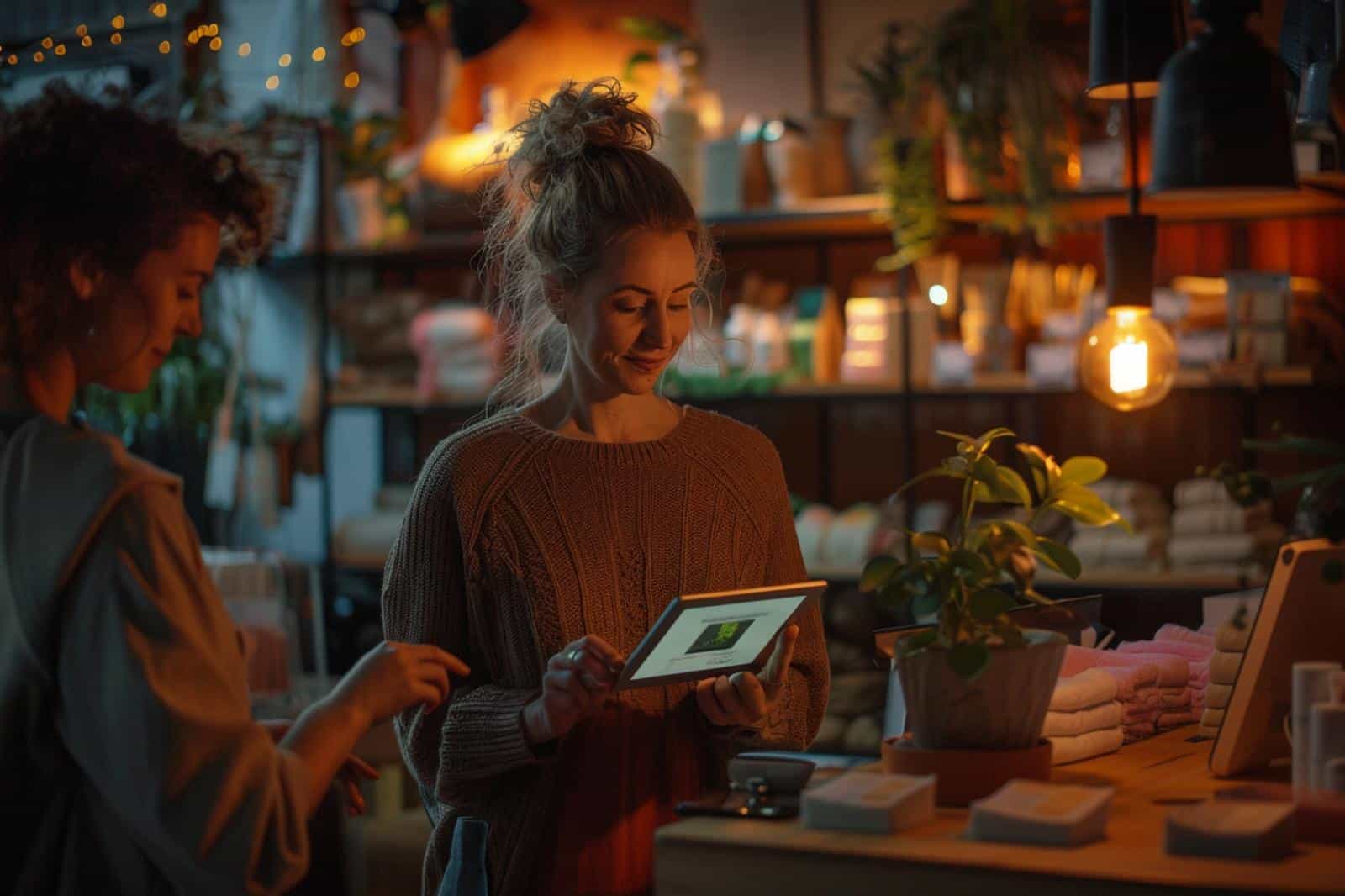How Can Small Businesses Use Technology to Enhance In-Store Customer Experiences?

In the age of digital revolution, technology has become an essential part of our everyday lives. With the increasing demand for personalized and seamless experiences, businesses are under more pressure than ever to adapt and evolve. Small enterprises, in particular, are constantly on the lookout for innovative ways to attract and retain customers. This article explores how small businesses can leverage different technologies to improve their in-store experience and drive sales.
Digital Tools for Personalized Experiences
The use of digital tools and software can significantly enhance the customer experience in a physical store. These tools can help businesses to gain a deeper understanding of their customers’ preferences and behaviors, enabling them to deliver more personalized services.
A lire également : How to Develop a Strong Corporate Social Responsibility (CSR) Program for Small Businesses?
One of the most effective ways to collect valuable customer data is through the use of digital loyalty programs. By offering customers rewards for their purchases, businesses can incentivize them to share their information. This data can then be analyzed to identify trends and patterns, which can be used to tailor the products and services offered to individual customers.
For instance, a boutique clothing store might use a digital loyalty program to track the types of clothes a customer typically buys. They could then use this information to recommend similar items or to alert the customer when new items that match their preferences arrive.
A lire en complément : What Are the Best Practices for Small Businesses in Managing Remote Customer Support Teams?
In addition to loyalty programs, small businesses can also use point-of-sale (POS) systems to collect and analyze customer data. These systems not only streamline the checkout process but also keep a record of each transaction. This data can be used to identify the most popular products and determine which ones are not selling as well, helping businesses to make more informed decisions about their inventory.
Technology for Improved Customer Service
Technology not only helps businesses to understand their customers better but also to provide superior customer service. There are several technologies that can significantly improve the customer service experience in a store.
For example, using customer relationship management (CRM) software, businesses can manage and analyze customer interactions and data throughout the customer lifecycle. This can improve customer service and drive sales by keeping track of customer preferences, purchase history, and feedback. It can identify opportunities for upselling or cross-selling and automatically send out personalized offers or promotions.
Alternatively, self-service kiosks can be a great way to reduce queues and wait times. These kiosks allow customers to check out items, look up product information, or place orders without the need for a staff member. This can free up staff time to focus on providing more personalized service to customers who need it.
The Role of Social Media and Online Presence
An online presence is crucial for small businesses in this digital age. Social media platforms can act as an extension of a physical store, allowing businesses to engage with customers, promote their products, and provide customer service.
By maintaining an active presence on social media, businesses can keep their customers informed about new products, special promotions, or upcoming events. They can also use these platforms to collect customer feedback and respond to queries or complaints in real-time. This can significantly improve the customer experience and build customer loyalty.
Moreover, an online store or e-commerce site can complement the in-store experience by offering customers the convenience of shopping from the comfort of their home. It can also provide additional information about products that may not be available in the store.
Incorporation of Emerging Technologies
Emerging technologies like Augmented Reality (AR) and Virtual Reality (VR) can take the in-store customer experience to a whole new level. These technologies allow customers to visualize products in a way that is not possible in a traditional retail setting.
For instance, a furniture store could use AR technology to allow customers to visualize how a piece of furniture would look in their home. Similarly, a fashion retailer could use VR technology to allow customers to "try on" clothes without having to physically change.
While these technologies may seem out of reach for small businesses, there are many cost-effective solutions available on the market. By incorporating these technologies, small businesses can provide an in-store experience that not only meets but exceeds customer expectations.
The application of technology in enhancing in-store experiences is vast and ever-evolving. It is important for small businesses to stay abreast of these developments and to continue exploring ways to improve the customer experience using technology. By doing so, they can increase customer loyalty, drive sales, and ultimately ensure their survival in a competitive market.
Leveraging Data Analytics for Customer Insight
In this age of digital transformation, data analytics can be an invaluable tool for enhancing the customer experience. It provides businesses the capability of collecting, analyzing, and interpreting vast amounts of customer data to gain a deeper understanding of customer behavior and preferences.
Small businesses, in particular, can benefit from data analytics by utilizing it to personalize the shopping experience. For example, data on purchasing trends can help business owners tailor their products and services to meet the unique needs and interests of their customers.
Moreover, real-time data analytics can provide up-to-the-minute information on customer behavior and trends. This allows businesses to respond quickly to changes in customer preferences, potentially maximizing sales and customer satisfaction.
For instance, if data analytics reveals a sudden surge in the popularity of a certain product, the business can quickly ramp up its inventory to meet demand, enhancing the customer experience by ensuring the product is readily available.
Employing data analytics can also aid in predicting future trends, allowing businesses to stay one step ahead and tailor their offerings accordingly. Therefore, it’s crucial for small businesses to incorporate data analytics in their strategy to provide a seamless and personalized customer experience.
Artificial Intelligence and Machine Learning for Superior Service
Artificial Intelligence (AI) and Machine Learning (ML) are revolutionizing the way businesses operate and interact with customers. These technology solutions can automate various aspects of a business, enhance customer service, and improve the overall shopping experience.
For small businesses, AI can be utilized for real-time customer service via chatbots. These AI-powered bots can provide instant responses to customer queries, offer product recommendations based on customer behavior, and even process orders. This can significantly enhance the customer experience by providing immediate and personalized service.
Machine Learning, on the other hand, can analyze historic customer data to predict future behavior and preferences. It can help businesses anticipate customer needs and offer personalized products and services.
For example, if the ML algorithms notice a customer typically purchases a certain type of product, the business can recommend similar products or offer promotions on those items, enhancing the customer’s shopping experience.
While AI and ML may seem complex, there are numerous cost-effective solutions available in the market that are well-suited for small businesses. By harnessing these technologies, business owners can provide a superior level of customer service and significantly improve the overall shopping experience.
Conclusion
In conclusion, technology has opened up a plethora of opportunities for small businesses to enhance in-store customer experiences. From leveraging digital tools for personalized experiences to using AI and ML for superior service, the possibilities are endless.
However, it’s crucial for businesses to remember that technology is just a tool. The ultimate goal should always be to improve customer satisfaction and the overall shopping experience. Therefore, business owners should keep their customers’ needs and preferences at the core of their digital transformation strategies.
As we move further into the digital age, those small businesses that successfully adapt and leverage technology to improve their in-store experiences will undoubtedly stand out from the competition and thrive in the marketplace.
